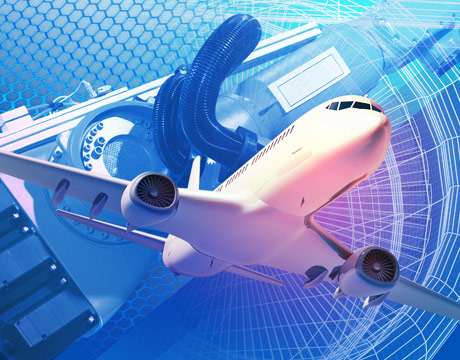Four Key Advanced Manufacturing Technologies Used in Aerospace
Four Key Advanced Manufacturing Technologies Used in Aerospace


Aerospace is a leading industry in the use of advanced manufacturing technologies. This is due largely to the unique challenges that exist for designing aircraft and spacecraft such as extreme environmental conditions; materials that must be strong, lightweight, and resistant to temperature and corrosion; and the extremely fine, tight-tolerance features that require micro- and nano-machining methods, including laser machining and welding. In fact, aerospace is often the first to come up with innovative advanced manufacturing approaches, which are later adopted by other industries. Below are four key advanced manufacturing (AM) technologies that are vital to aerospace manufacturing today.
Additive Manufacturing
Aerospace was quick to recognize the huge potential of AM for designing parts with advanced materials and unique geometries. Powder-bed laser printing systems are preferred for most components; however, other laser and electron beam systems are also used. AM can also be used to make lattice structures, especially within the fuselage, which reduce weight and help dissipate heat. AM is also an excellent way to create a single part that replaces many multiple parts, which reduces the number of possible failure points and simplifies assembly. Fused deposition modeling (FDM) is an AM technique that deposits ultra-thin layers of semi-molten thermoplastics to create semi-hollow parts such as honeycomb structures for the wings of unmanned aircraft systems, thereby reducing weight but also adding strength. AM is also moving toward building larger parts up to two meters in size. For example, GKN Aerospace and the U.S. Energy Department’s Oak Ridge National Laboratory have recently partnered to develop a large-scale AM process for manufacturing large titanium aerospace components. The process—laser metal deposition with wire (LMD-w)—uses a robot-mounted laser to melt the surface of a titanium substrate, creating a localized pool of molten titanium into which titanium wire is fed to form a bead. Advanced robotic controls manipulate this melt pool along a 3D path to fabricate a large near-net or net-shaped aerospace preform, bead by bead, as defined by a computer-assisted design (CAD) model. Advantages of LMD-w over other AM deposition processes include the ability to manipulate widely tunable laser-energy and wire-feed rates. "These features enable a user-selectable deposition rate and control of material properties," says Josh Crews, GKN's technology center manager for additive manufacturing in St. Louis. “In addition, wire feedstock used in LMD-w is completely consumed in the melt pool. Powder-based deposition typically has powder incompletely consumed in the melt pool.”
Composite Materials
Aerospace engineers continue to rely on advanced composite materials, usually metals or plastics with precise amounts of certain additives to enhance physical characteristics such as strength, flexibility, and chemical and temperature resistance. A major goal with composites in aerospace is creating aircraft and spacecraft that weigh less. Lighter vehicles use less fuel and reduce carbon emissions. Carbon, glass, metal, and ceramics are essential components in composites. Physical properties vary according to formulation chemistry and particle alignment. Advanced polymers, composite materials, and nanomaterials are often key to performance breakthroughs and reductions in lifecycle costs. Although many improvements in composites are new formulations for the materials themselves, other impressive advances include enhancements in the manufacturing machinery—especially software advances for machine control and simulation, assembly processes, and inspection. Robotics Robots—especially for lifting and handling—are a common sight on aerospace manufacturing floors. “There will be a lot more robotics and automation to get rid of the labor-intensive processes,” says Scott Beckwith, global technical director for the Society for the Advancement of Material and Process Engineering. Robot tasks include inspection, drilling and fastening, welding, and sealing and dispensing. Large, fixed auto-riveting machines are popular. Industrial robots are increasingly employed to connect aircraft sections. For example, a crawling drilling-riveting robot with a flexible drilling head can move gently over the aircraft skin to join fuselage panels together. Robotics is also handling the tasks that are most hazardous to workers, such as welding and painting. “An entire welding project can be completed with only a small fraction of the usual waste,” states the Robotics Industries Association. “This makes it cost-effective when using expensive metals. Applying coatings to a large-scale fuselage can be a long, tedious, and potentially dangerous undertaking for workers. Robotic arms situated on rails can effectively apply sealant, paint, and other coatings at distances up to several stories.”
Laser Beam Welding
Laser welding provides rapid and high-precision processing, compared to other welding techniques. Therefore, laser welding isa good solution for handling material when high precision and repeatability are required. It is also an effective process for joining dissimilar materials together, which can be a problem for traditional welding techniques. Perhaps the greatest advantage of laser welding is that it transfers very little heat to the material being welded. It does not create a heat-affected zone around the weld. There is no cracking or material weakness that could otherwise compromise the performance of the joint. Laser machining applications include pressure vessel welding, orifice drilling, proximity sensors welding, leading-edge hole drilling, battery welding, and sensitive electronics glove box welding. “For the aerospace industry, laser welding capabilities play an integral role in everything from flight components to airport security procedures,” states Laserage, a precision laser-processing shop. “Because laser-enabled welding provides precision from start to finish, it serves as an effective process for not only an impressive array of industry projects, but especially for materials used in provenaerospace applications.”
Mark Crawford is an independent writer.





